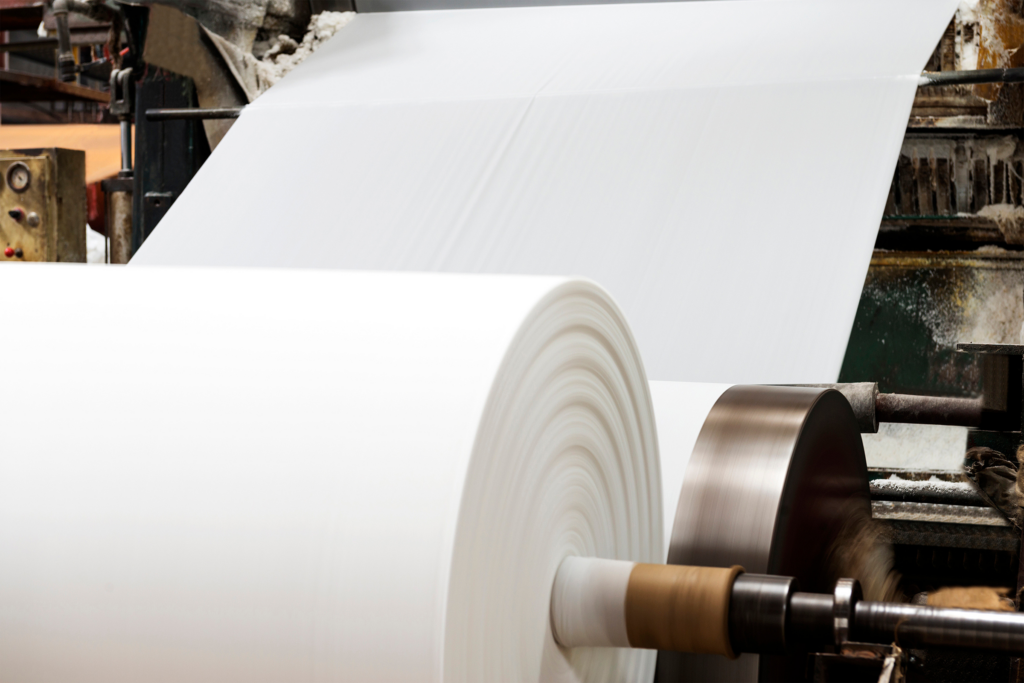How Wood-Free Paper Reduces the CO2 Impact of Printing: Sugarcane, Stone and Bamboo

Sustainable printing is not about how much one prints, as it’s far more important to make sure sustainable paper is used. Such poses the question: what type of paper is sustainable?
If one looks at the CO2 impact of printing, it’s apparent that the actual printing itself is not as significant as one might think. About 6g of CO2 is produced per page. That means a cappuccino made with cow’s milk produces roughly the same amount of CO2 as 40 pages will.
In fact, only 1g of CO2 is produced by the printing process and the rest occurs during the paper production process itself.
So although it is not possible to eliminate paper and printouts entirely, looking for more sustainable options in terms of tree-free paper alternatives can make a big impact.
Paper From Sugarcane (Bagasse)
How to Make Paper From Sugar Cane
Sugarcane paper consists of residues from sugar production, namely bagasse. Due to the high demand for sugar, a lot of bagasse is produced and typically the product is not reused but incinerated. Companies that take on this waste product can process it not only into paper, but also into biodegradable tableware, napkins, and tissues. In this way, the environment is less negatively impacted from increased CO2 pollution.
If one would like to make paper from bagasse, the sugar juice has to be squeezed out, and then the remaining sugar fibers can be processed into paper which can be bleached and sold.
To make one ton of paper from 100% sugar cane, one would need 6 tons of bagasse, which is about twice as much as is needed for paper made from wood, yet, bagasse is ready to use in factories, whereas trees would have to be cut down for wood. In addition, the production of one ton of paper from bagasse requires about 9,000 kilowatts less energy than conventional paper. Additionally, bagasse paper uses less chemicals.
Unfortunately, exact information on water consumption cannot be found. A 2011 study concluded that, in general, consumption of water, energy, and trees is lower when paper is made from non-traditional materials such as wood-free materials. Such finished paper is robust, can be printed on, and is also resistant to water and oils.
Why Use Paper Made From Sugarcane?
Since bagasse is a waste product and would be burned for no other purpose, one helps the environment significantly by continuing to use it. In addition, sugar cane grows much faster than normal trees, which would have to be cut down instead. Bagasse can also be used to make cutlery and tableware in addition to paper. If no other materials are added, this paper is even biodegradable in the end.
Bamboo Paper
Bamboo paper is usually a misleading term as it suggests that the paper is made exclusively or mostly of bamboo paper, but it often contains more bagasse than bamboo. At baumfrei, for example, you can find paper made from 30% bamboo and 70% sugar cane. Bamboo paper is very similar to the white shade of conventional paper, which makes it especially suitable for people who are particularly dependent on this.
Stone Paper – An Alternative Without Wood and Without Water
What Is Stone Paper
Stone paper is a natural product made from waste from limestone mines and is therefore completely wood-free. This waste is calcium carbonate (CaCo3) ground into powder and has been used in the paper industry for some time to make the paper shine, but in stone paper production it accounts for 80%. In order to process the calcium carbonate into stone paper, it must be enriched with non-toxic polyethylene resin (HDPE). In line with the cradle-to-cradle principle, the HDPE can also be obtained from waste materials, such as old PET bottles, and from plant sources.
The cradle-to-cradle concept stands for a perfect cycle without waste. To obtain the associated certification, companies must provide four verifications. These concern the ingredients, the recyclability, the renewable energies in the product cycle, the water use, as well as the social aspects of the company. According to the Swiss Environmental Information Foundation, many producers of rock paper are trying to meet these requirements.
The website Rockpaper reports that no drinking water is needed for stone paper and no trees have to be cut down. This saves about 60,000 liters of water for one ton of stone paper compared to conventional paper made from 100% pulp, and almost 35,000 liters compared to recycled paper. Energy consumption is also very low compared to conventional and recycled paper as 5,700 kilowatt hours can be saved per ton of stone paper, which requires less than 1000 kilowatts per ton.
Stone Paper Characteristics
According to Stone-Paper’s website, the finished paper is anti-static, grease-resistant, waterproof, tear-resistant, and has no grain direction. It is also acid-free and no bleaches or bases or other fluorescent chemicals are added to it.
Another advantage of stone paper is that it can be printed on without any problems. Not only that, but the paper’s fiber-free surface prevents printer ink from being absorbed, which actually saves ink. However, very warm printers, such as laser printers, are less suitable for this as the heat damages the paper. Generally, stone paper decomposes as soon as it is exposed to sunlight, but temperatures as low as -40 degrees do not impact its condition.
Summary
All papers are perfectly suitable for everyday use, but all have weak points if the entire paper production process has to be changed over to them.
Two problems result from the plastic content of the stone paper. First, paper consumption is too high for us to meet the plastic demand for the stone paper, and second, the paper may only be disposed of in a yellow garbage can. Sugar cane has a long transport route and is therefore also of limited suitability for many countries.
Although both paper alternatives offer a good alternative to tree paper, they do not appear to be the ultimate solution for sustainable paper. For a more detailed comparison of the sustainability of recycled paper and the paper alternatives mentioned, click here.

